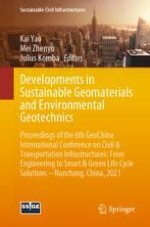2021 | OriginalPaper | Chapter
Settlement Problem of Streets and Light Structures in Bogotá
Authors : Marcela Salcedo, Luis F. Orozco
Published in: Developments in Sustainable Geomaterials and Environmental Geotechnics
Publisher: Springer International Publishing
Activate our intelligent search to find suitable subject content or patents.
Select sections of text to find matching patents with Artificial Intelligence. powered by
Select sections of text to find additional relevant content using AI-assisted search. powered by
